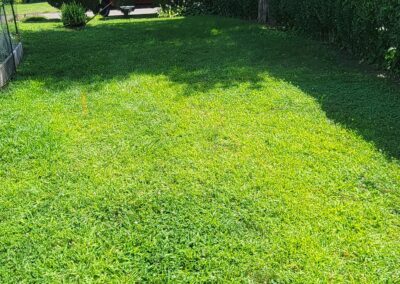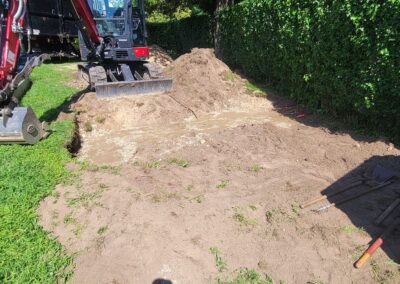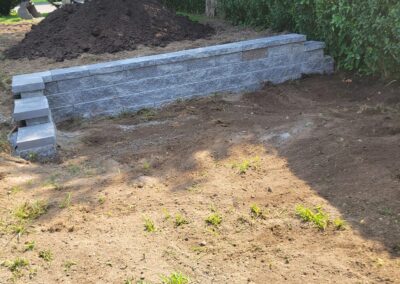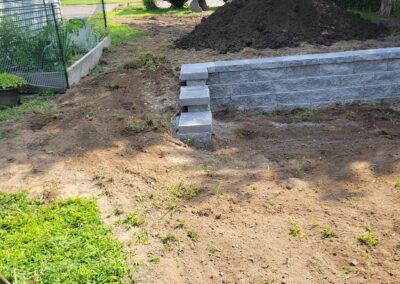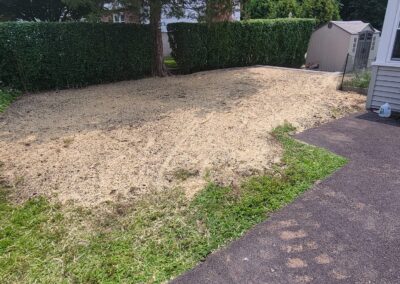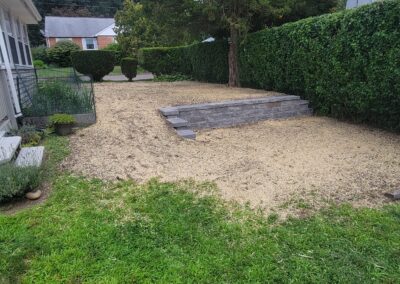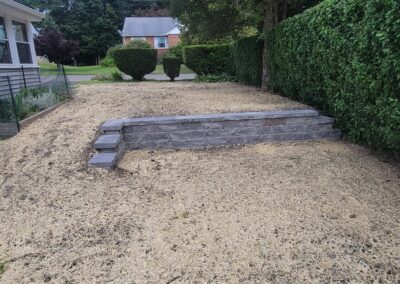Riley Tree and Landscaping recently completed a retaining wall and lawn installation project in Oxford, CT. Both retaining wall construction and lawn care installation are important aspects of landscaping that can significantly enhance the appearance and functionality of outdoor spaces. Contact us today at (203) 617-0832 to schedule a quick no-cost quote!
1. Retaining Wall Build:
A retaining wall designed and constructed by Riley Tree and Landscaping is a structure designed to hold back soil and create different levels or terraces in a landscape. They serve both functional and aesthetic purposes, often preventing erosion, managing water runoff, and adding visual interest to outdoor areas. Here’s an overview of the retaining wall construction process:
- Planning and Design: Determine the purpose of the retaining wall, such as preventing soil erosion, creating usable terraced spaces, or enhancing the overall landscape design. Choose the materials for the wall, which can range from natural stone and concrete blocks to wood or other decorative options.
- Site Preparation: Clear the area where the retaining wall will be built. Ensure the foundation is stable and properly graded.
- Excavation: Dig a trench for the base of the wall. This trench will be filled with a layer of compacted gravel to provide stability.
- Foundation and Base: Lay the first row of stones or blocks, making sure they are level and properly aligned. Backfill the area behind the wall with gravel, and compact it to create a solid base.
- Layering and Stacking: Continue adding rows of stones or blocks, staggering them to provide stability. Use construction adhesive or interlocking mechanisms to secure the blocks together.
- Drainage: Depending on the height and purpose of the wall, consider adding drainage pipes or gravel-filled trenches behind the wall to manage water runoff.
- Finishing: Complete the wall with capstones or a finishing row of blocks for a polished look.
2. Lawn Care Installation:
Lawn care by Riley Tree and Landscaping involves creating and maintaining a healthy and lush lawn through proper planting, fertilization, irrigation, and regular maintenance. Here are the key steps in lawn care installation:
- Soil Preparation: Test the soil to determine its pH and nutrient levels. Amend the soil as needed to create an ideal environment for grass growth.
- Grass Selection: Choose the appropriate grass species or seed mixture based on your climate, soil type, and sun exposure. Common grass types include Bermuda, Kentucky Bluegrass, Fescue, and Zoysia.
- Seeding or Sodding: Decide whether to seed the lawn or lay sod. Seeding is cost-effective but requires more time for grass establishment. Sod provides an instant lawn but is more expensive.
- Watering: Proper watering is crucial for establishing new grass. Water deeply and consistently to encourage root growth.
- Fertilization: Apply a balanced fertilizer to promote healthy growth and strong roots. Follow recommended application rates and timings.
- Mowing: Regular mowing maintains the health and appearance of the lawn. Adjust the mower height based on the grass type and avoid cutting more than one-third of the grass height at a time.
- Weed Control: Keep an eye out for weeds and address them promptly through manual removal or appropriate herbicides.
- Aeration: Over time, soil can become compacted, hindering water and nutrient absorption. Lawn aeration involves perforating the soil to alleviate compaction and improve air exchange.
- Dethatching: If your lawn develops a thatch layer (accumulation of dead grass and debris), dethatching may be necessary to prevent water and nutrient blockage.
We have included photos from a recent retaining wall and new lawn installation project we recently completed in Oxford, CT. You can click any of the thumbnails to launch the slideshow. You can click the following link to view our many 5-star Home Advisor Reviews. Contact us today at (203) 617-0832 to schedule a quick no-cost quote!


